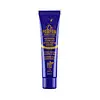What's inside
What's inside
 Key Ingredients
Key Ingredients

 Benefits
Benefits

 Concerns
Concerns

 Ingredients Side-by-side
Ingredients Side-by-side

Ricinus Communis Seed Oil
MaskingHydroxystearic Acid
CleansingHelianthus Annuus Seed Oil
EmollientEuphorbia Cerifera Wax
Olea Europaea Fruit Oil
MaskingRicinus Communis Seed Oil, Hydroxystearic Acid, Helianthus Annuus Seed Oil, Euphorbia Cerifera Wax, Olea Europaea Fruit Oil, Ethylhexyl Palmitate, Carica Papaya Fruit Extract, Tribehenin, Aloe Barbadensis Leaf Extract, Sorbitan Isostearate, Rosmarinus Officinalis Leaf Extract, Palmitoyl Tripeptide-8
Hydrogenated Polybutene
Caprylic/Capric Triglyceride
MaskingSorbitan Olivate
EmulsifyingPolyglyceryl-3 Polyricinoleate
EmulsifyingPhytosterols
Skin ConditioningButyrospermum Parkii Butter
Skin ConditioningPanthenol
Skin ConditioningMicrocrystalline Wax
Emulsion StabilisingIsopropyl Myristate
EmollientCandida Bombicola/Glucose/Methyl Rapeseedate Ferment
AntimicrobialOlea Europaea Fruit Oil
MaskingHelianthus Annuus Seed Oil
EmollientArgania Spinosa Kernel Oil
EmollientAngelica Gigas Root Extract
Skin ConditioningLithospermum Erythrorhizon Root Extract
Skin ConditioningGlycyrrhiza Uralensis Root Extract
Skin ConditioningCamellia Sinensis Leaf Extract
AntimicrobialChamomilla Recutita Flower Extract
MaskingCentella Asiatica Extract
CleansingLavandula Angustifolia Flower Extract
CleansingAloe Barbadensis Leaf Extract
EmollientUsnea Barbata Extract
Pulsatilla Koreana Extract
Skin ConditioningZanthoxylum Piperitum Fruit Extract
Skin ConditioningAnemarrhena Asphodeloides Root Extract
Skin ConditioningHydrogenated Polyisobutene
EmollientEclipta Prostrata Extract
Skin ConditioningMelia Azadirachta Leaf Extract
Skin ConditioningMoringa Oleifera Seed Oil
EmollientHydrogenated Lecithin
EmulsifyingCeramide NP
Skin ConditioningGlycerin
HumectantPersea Gratissima Oil
Skin ConditioningOenothera Biennis Oil
EmollientTocopherol
AntioxidantWater
Skin ConditioningBeeswax
Emulsion StabilisingHydrogenated Polybutene, Caprylic/Capric Triglyceride, Sorbitan Olivate, Polyglyceryl-3 Polyricinoleate, Phytosterols, Butyrospermum Parkii Butter, Panthenol, Microcrystalline Wax, Isopropyl Myristate, Candida Bombicola/Glucose/Methyl Rapeseedate Ferment, Olea Europaea Fruit Oil, Helianthus Annuus Seed Oil, Argania Spinosa Kernel Oil, Angelica Gigas Root Extract, Lithospermum Erythrorhizon Root Extract, Glycyrrhiza Uralensis Root Extract, Camellia Sinensis Leaf Extract, Chamomilla Recutita Flower Extract, Centella Asiatica Extract, Lavandula Angustifolia Flower Extract, Aloe Barbadensis Leaf Extract, Usnea Barbata Extract, Pulsatilla Koreana Extract, Zanthoxylum Piperitum Fruit Extract, Anemarrhena Asphodeloides Root Extract, Hydrogenated Polyisobutene, Eclipta Prostrata Extract, Melia Azadirachta Leaf Extract, Moringa Oleifera Seed Oil, Hydrogenated Lecithin, Ceramide NP, Glycerin, Persea Gratissima Oil, Oenothera Biennis Oil, Tocopherol, Water, Beeswax
 Reviews
Reviews

Alternatives
Ingredients Explained
These ingredients are found in both products.
Ingredients higher up in an ingredient list are typically present in a larger amount.
Aloe Barbadensis Leaf Extract is an extract of the leaves of the aloe, Aloe barbadensis, Liliaceae.
Aloe is one of the most well-known natural soothing ingredients, and for good reason. It’s full of water and has a cooling, calming effect on the skin, especially when it’s sunburned, itchy, or irritated. Aloe also helps your skin stay hydrated and smooth by mimicking what healthy skin naturally produces. On top of that, it contains vitamins and nutrients that support skin recovery.
It doesn’t protect you from the sun, but it can help your skin bounce back after too much time in it.
Let’s get into the details:
Aloe contains antioxidant Vitamins A, C, and E, which help fight off free radicals (unstable molecules from things like pollution that can damage your skin).
It’s also rich in polysaccharides, which are natural sugars that help hydrate the skin by acting like the skin’s own moisturizing agents. These, along with other sugars like monosaccharides, help form a protective barrier that locks in moisture.
Aloe works as both a humectant and an emollient. That means it draws water into the skin (humectant) and helps trap it there (emollient), making it an effective natural moisturizer.
You’ll also find a mix of other skin-supporting ingredients in aloe, including folic acid, choline, calcium, amino acids, fatty acids, and even Vitamin B12.
Out of the 420+ species of aloe, Aloe barbadensis is the most widely used in skincare products thanks to its gentle yet effective properties.
There are over 420 species of aloe but Aloe Barbadensis is the most commonly used for topical products.
Learn more about Aloe Barbadensis Leaf ExtractHelianthus Annuus Seed Oil is the oil derived from the seeds of a Sunflower. Sunflower seed oil is non-fragrant. It is an emollient, meaning it helps to soften the skin.
Sunflower seed oil contains many fatty acids. The fatty acids found in sunflower seeds include (from highest amount to least): linoleic acid, myristic acid, palmitic acid, stearic acid, arachidic acid, oleic acid, and linolenic acid.
These fatty acids help the skin create ceramides. Ceramides play a role in repairing the skin barrier.
Helianthus Annuus Seed Oil helps moisturize the skin. This in turn helps the skin look more rejuvenated and smoother.
Sunflowers are rich in vitamin E.
Historians believe Indigenous cultures of North America domesticated sunflowers before corn. Thus they relied on sunflower oil for a variety of uses. One such use is moisturizing skin and hair.
Sunflower seed oil may not be fungal acne safe. We recommend speaking with a professional if you have any concerns.
Learn more about Helianthus Annuus Seed OilOlea Europaea Fruit Oil is the fixed oil obtained from the ripe fruit of the Olive. In other words - olive oil.
The primary contents of olive oil are glycerides of the fatty acids linoleic, oleic and palmitic.
Olive oil also contains antioxidants such as Vitamin E. Antioxidants may help reduce signs of aging by fighting unstable free-radical molecules. It also contains Vitamins A (retinol), D, and K.
The squalene in olive oil makes it a great emollient. Emollients help soothe and soften your skin by trapping moisture in. This makes olive oil a great skin moisturizer.
Studies show olive oil to have antibacterial and antifungal properties in low concentrations. Another study found olive oil irritated sensitive oily skin. We always recommend speaking with a professional about using this ingredient in your routine.
Due to the fatty acid content, this ingredient may not be fungal-acne safe.
Learn more about Olea Europaea Fruit Oil